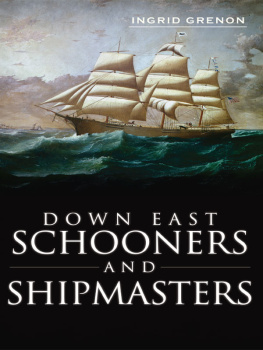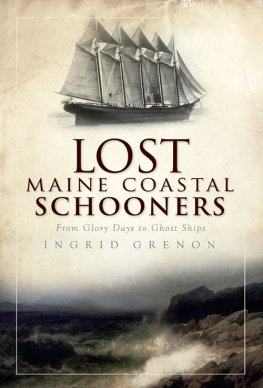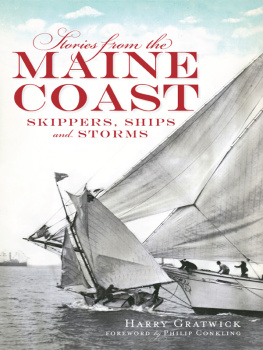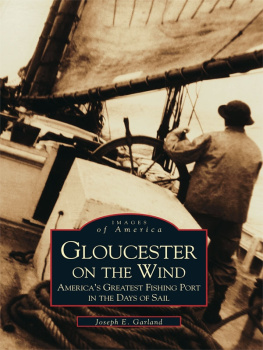

Published by The History Press
Charleston, SC 29403
www.historypress.net
Copyright 2012 by Ingrid Grenon
All rights reserved
Front cover: The fully rigged Great Admiral. Courtesy of the Penobscot Marine Museum.
First published 2012
e-book edition 2012
ISBN 978.1.61423.368.8
print edition ISBN 978.1.60949.514.5
Library of Congress CIP data applied for.
Notice: The information in this book is true and complete to the best of our knowledge. It is offered without guarantee on the part of the author or The History Press. The author and The History Press disclaim all liability in connection with the use of this book.
All rights reserved. No part of this book may be reproduced or transmitted in any form whatsoever without prior written permission from the publisher except in the case of brief quotations embodied in critical articles and reviews.
CONTENTS
To my ancestors Thomas Richardson and Daniel Gott, who were among the very first Europeans to settle on Mount Desert Island in 1768, and also to my native ancestors who resided in the province known as Maine long before any Europeans appeared.
ACKNOWLEDGEMENTS
From the Hancock Historical Society, I wish to thank Bertha Smith, Jim Singletary and especially Lois Crabtree Johnson for all her time and endless photocopying, as well as the many wonderful ideas she had for this book.
I wish to thank Ann Benson, Tim Garrity and Deb DeForest from the Mount Desert Historical Society for their time and effort.
I am most grateful for the help of my distant cousin Ralph Stanley and his wife, Marion, from Southeast Harbor on Mount Desert Island.
I owe a debt of gratitude to Cipperly Good, Ben Fuller, Don Garrold and photo archivist Kevin Johnson from the Penobscot Marine Museum in Searsport for allowing me to peruse the Foss Collection and especially for finding the log of the Edna Hoyt for me.
I would like to thank marine photographer Craig Milner for helping with the color pictures and editor Whitney Tarella for her invaluable support.
Finally, I wish to thank the crew of the schooner Lewis R. French for allowing me to take a few turns at the helm.
Introduction
BLOOD, SEA AND EARTH
My last book, Lost Maine Coastal Schooners: From Glory Days to Ghost Ships (The History Press, 2010), was the product of a most unusual circumstance. From out of nowhere, at nearly a half century of age, I became obsessed with Maine schooners. An avid equestrian and professional horsewoman for thirty years, I set aside my boots and spurs and began to research Maine maritime history. I recalled my fascination with the old beached Wiscasset Schooners that I had first seen as a small child going home from a clambake in Boothbay. I begged my parents to stop so that I could see the vessels more closely. Many a child growing up in Maine must have seen the old wrecks on numerous occasions, but my fascination never waned. I remembered that my great-great-great-grandfather Captain William Peachey, who was born on Mount Desert Island in 1805, was a master of schooners. Next, I began to hear the sound of the ocean and seemed to intuitively know what it was like to be on a sailing vesselalthough I had never sailed in my life. I seemed to have a familiarity with nautical terminology that I had no conscious recollection of ever hearing before.
After the publication of Lost Maine Coastal Schooners, I thought it was over; I believed my sudden and impassioned fascination with Down East schooners and Maine history had ended and that I could go back to riding and training horses, enjoying a brisk morning canter on a favorite equine without being distracted by thoughts of sailing vessels and such. But I was wrong; it had not ended. In fact, it had only begun.
Mount Desert Island called to me just as the island of Bali Hai called to Lieutenant Cable in Rogers and Hammersteins South Pacific. I could not get it out of my mind. I remembered that I had ancestors who were among the first to settle Mount Desert Island in the eighteenth century. I wondered if that was part of what was happening.
Last summer, I felt compelled to book passage on the nineteenth-century coasting schooner Lewis R. French. I stood on the schooners deck one evening, watching the sun slowly set just beyond the bowsprit of the majestic vessel, wondering what this obsession with maritime history was all about. We were anchored off Stonington Harbor, where my ancestor had undoubtedly stood at anchor many times in his schooners. How had I become such an unlikely passenger aboard this vessel? I stood watching the sun set; orange, pink, yellow and gold beams extended from the horizon and illuminated the sea around the old schooner. The kerosene lanterns hung in the rigging were casting an eerie glow as present turned into past and past into present, until it was difficult to discern one from the other. And then the answer seemed to appear. At that moment, I thought I heard a voice whisper into my ear, and it seemed to say, Blood, sea and earth.
Did I really hear that or did I imagine it? I dont know what place parapsychologist Carl Jungs term synchronicity has in history books, but many strange meaningful coincidences began to occur. Interestingly, I found that the man who built the Lewis R. French, and after whom the vessel was named in 1871, was a cousin to an ancestor of mine. I also learned during an initial facet of my research that the shipmaster about whom I write in this book, Captain Harold Foss, was also a distant cousin. As I proceeded with my research, I discovered that many of the people I was meeting were connected to me through blood ties that went back hundreds of years. These are only a few examples of a myriad of occurrences with which I will not tire the reader. It certainly seems, however, that once we are linked by blood, sea and earth we remain so throughout the centuries.
The focus of this history book is people. Some of them have had a tremendous impact on the Maine we see today and some almost no impact at all. Many folks, if not for this book, would likely have long since passed into the realm of the forgotten; I have tried to wake them from their undusted sepulchers and give them a voice. Many others, however, have irrevocably changed the course of history, and their stories have been told countless times before this.
There have been many histories published related to Mount Desert Island, but the histories of the town of Hancock are relatively scant. Many of the stories I have chosen to place in this history arent well known, and that is why I have selected them. For a more complete history of Mount Desert Island, the reader has many choices. This book, however, is unique and contains information not found in any other account of the region. In addition, it focuses on the strong blood ties the people of coastal Maine have with the seaties that still bind, unbelievably, into the present day.
I find it difficult to tell the history of a place and not include the people who were native to the region. The European explorers and colonists literally invaded the American continent beginning in the sixteenth century. They took what they wanted with little or no regard for the native people, as if it was their right to disperse and eliminate an entire civilization. I am descended from both the English colonists and the native Wabanaki and without either would cease to exist. I have tried to represent each race equitably and tell their stories as accurately as possible.
Next page










